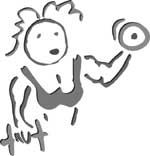
Alumnus Takes New Look at Personal
Fitness
 |
By Vanessa Maxey Traditionally, students have played team sports
in their physical education classes, but Acquaviva believes in a new fitness
curriculum that is more cognitively based and follows his theory for personal
fitness. Success in personal fitness will be easier to achieve later in life if
individuals rely on themselves, Acquaviva says. "Students need to be
taught personal fitness, not just team sports," he says.
"This way they'll have the tools to use on their own throughout their
lives instead of relying on a team of players to stay in shape." Acquaviva's model breaks the fitness process
into five levels of readiness: (1) not thinking about getting into shape; (2)
thinking about it but not doing it; (3) working out but not regularly; (4) working
out regularly but not for longer than six months; and (5) working out regularly
for more than six months. Under his model, everyone fits into a stage and has
the ability to advance or digress at any time. Acquaviva uses his theory to teach his own
students at Roanoke College. He has also persuaded the Roanoke area schools to
adopt new ways of teaching physical education and plans to propose his theory
to the Fairfax County Public Schools. "I enjoy teaching fitness and helping
people with those aspects--how to lose weight, how to feel better, how to
alleviate stress--but I also teach students how to help other people be more
healthy." Acquaviva earned his Ph.D. in physical education from
Florida State University after receiving his master's degree in physiology from
Mason. "I wanted to learn the educational side of fitness because I'm
best at teaching," says Acquaviva. As a physical trainer, he gets a kick out of the
common misconceptions students have about health and fitness. "It's
funny what people will come in and ask me. First of all, there's no such thing
as spot reduction," he says. "A student came in the other day
and asked what she had to do to lose weight in her face. You can't do that.
...[I]t's about more overall fitness and working out. The body will shape
itself the way it's supposed to." Acquaviva finds working with his students the
best part of his job. "College students are fun--they're full of
energy, they have personality and a sense of humor. They are fun to be around,
and they are fun to work with. What is most rewarding is pushing them to
certain levels and having them reach those levels." Meanwhile, Acquaviva is pushing his own career
to new levels. With two articles about his model in the works, he hopes his
program will gain the approval of fitness researchers. He also is gaining more
attention from the public. Acquaviva has been interviewed by the New York
Times, and his model for personal fitness was featured on television. He is
also "the trainer" on the popular Ask the Fitness Trainer
page on the healthAtoZ web site. Because of the site's voluminous traffic, he
has had to cut back from answering all questions submitted to only those with
the widest audience appeal. All this publicity has helped to better educate students about fitness and
to clear up those common misconceptions about getting into shape. With
a little determination, Acquaviva's ideas might lead to a healthier America.
For most people, routine exercise is nothing
more than a broken promise. For John Acquaviva, M.S. '90, exercise is both a
way of life and a career. Acquaviva is an assistant professor of physical
education at Roanoke University, and his ideas on physical education may change
the way children are taught fitness.